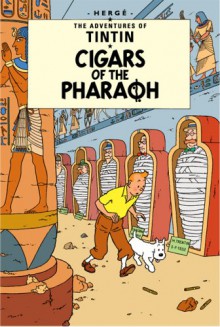
This is the story where Tintin comes on his own. While it was still written in a serialised form when it first appeared back in 1934, this story has a proper story arc where Tintin stumbles on a sophisticated drug smuggling ring that stretches across the entire Eurasian continent. It is here that Tintin's companions begin to be developed (namely the Thompson twins) and we also begin to see Tintin going on real adventures and chasing after a singular bad guy. Where Tintin in America seemed to be a hodge podge of different stories thrown together, here we begin to see a well constructed adventure.
Tintin is on a Mediterranean cruise (much to Snowy's annoyance - and here we begin to see the character of Snowy, the loyal and faithful companion, developed as well) when he runs into the first of Herge's many absent minded professors, Dr Sophocles Sarcophagus. He is travelling to Egypt to uncover a lost tomb. Tintin also meets one of the recurring villains of the piece, the film mogul Rastapopolous. Herge developed this character very well in this book because we do not, at this stage, realise that he is the bad guy, and in fact when the master of the drug ring falls off a cliff at the end, we are left wondering who it was and whether we will ever find out.
While this story can be read on its own, it does carry over to the Blue Lotus, however I never got to read the Blue Lotus until a long time afterwards. As for this story, it is by far my favourite of the Tintin adventures. Some have suggested that Herge had not got the culture element right here, but we will note that after the Blue Lotus, Herge begins to create his own countries where the adventures are placed, and maybe it is a move away from raising clearly raising his concerns to being much more subtle in his criticism.
Yet we do have criticism within this story (as we do with the next one as well). It is not until Tintin reaches India that we are confronted with the destruction that a lot of these drug smuggler's are causing. While as a kid we read this book and considered that drugs smuggling was bad because Tintin is out to get them, it is when he meets the Raj of Gaipajama that the major concern is raised. The Raj is out to stop the smugglers because of the suffering they cause his people (and Herge is obviously trying to raise awareness of the practice, which still occurs today), namely that the smugglers force the peasants to grow opium poppies and purchase the poppies off of them at a significant discount. However, because the peasants are growing poppies they are unable to grow their own food, and as such are forced to purchase food off of the smuggler's at a significant premium.
The comedy is ramped up a lot here as well. Tintin in America was simply silly in a lot of cases, but now we have the Thompson twins, two Interpol Agents (I believe, though the English versions suggest that they are Scotland Yard) who bumble their way through the investigation, and but end up being the assistance that Tintin needs to crack the case. The most amusing part was where they think they see Tintin sitting behind a dune and whack him on the head with a cane only to discover it is a sheik. In the next panel, Tintin arrives at a city that is being mobilised for war because one of their sheiks was attacked. Then there are the three huge Indians let into Tintin's cell, to teach him a lesson, and then we hear the sounds of fighting, and an ambulance rushing off to pick up the wounded, only to discover that it was the three Indian dudes – golden.

 Log in with Facebook
Log in with Facebook 





